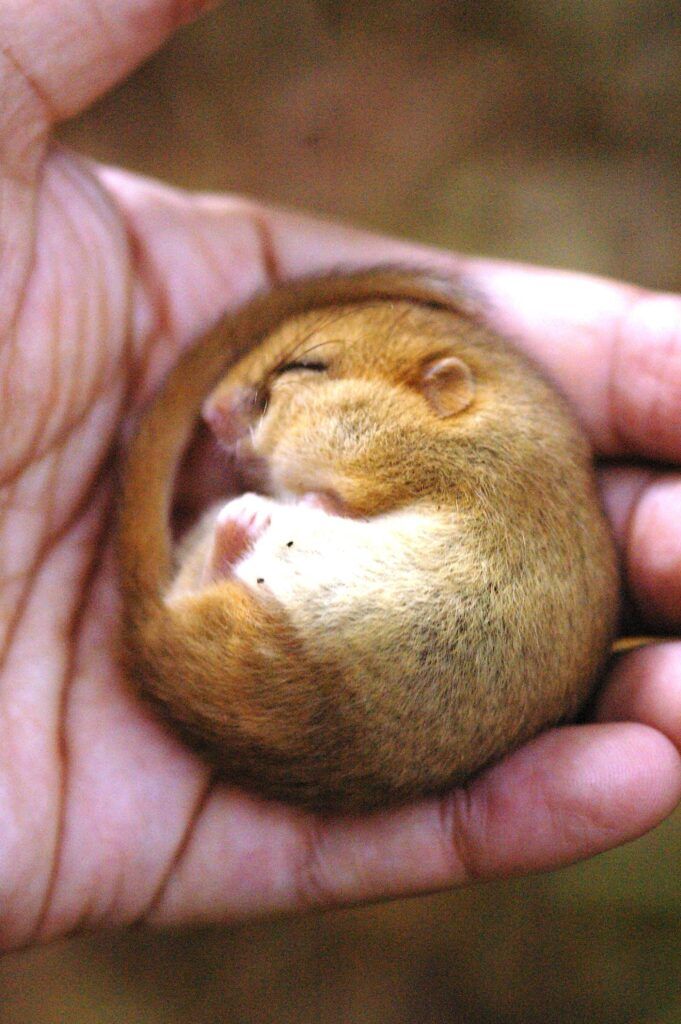Back to Beds for sleepy dormice
This week, in early June, 10 rare hazel dormice have been reintroduced into a Bedfordshire woodland to bolster the county’s only existing population. These animals will help create a bigger and more genetically diverse population of the species in this wood, and is part of our ongoing conservation effort to save dormice from extinction in the UK.
Hazel dormice have golden-brown fur and large black eyes. They’re the only small mammal in the UK that has a furry tail. Being nocturnal and arboreal (spend most of their time in trees, scrub and hedgerows) they’re notoriously elusive. Sometimes dormice are discovered sleeping in old birds’ nests but generally they weave their own (often in brambles or other shrubs) from strips of honeysuckle bark or a similar plant, surrounded by a layer of green leaves. When conditions are cold or wet, or if food is scarce, dormice curl up into a ball and go into a state similar to hibernation for a short time (called torpor) in order to save energy.
Our previous dormouse release in Bedfordshire took place in 2001, in the same woodland which is cared for by Forestry England. Over the past 23 years, the population has thrived, with their range extending beyond the original release area. Now, a further 10 animals will be added to the existing population.
Why do hazel dormice need our help?
Britain’s hazel dormouse population has plummeted by an astounding 70% since 2000. They’ve been lost from 20 English counties over the past century. Our annual reintroductions, alongside habitat management, landscape projects and monitoring, are paramount to the species’ long-term survival. To date, we’ve released 1,112 dormice into 25 different woodlands in 13 counties – including six English counties where they’d previously been lost. It’s extremely encouraging that descendants of Bedfordshire’s original population are still flourishing and, by introducing more dormice this summer, we hope that they’ll continuing going from strength-to-strength. It’s much-needed good news for a species on the brink.
We’ve managed the annual dormouse reintroductions since 2000. They’re part of Natural England’s Species Recovery Programme, and the release day is the culmination of months of hard work by several partner organisations, including the Common Dormouse Captive Breeders Group (including Wildwood Trust), Paignton Zoo and ZSL. This year, dormice have been released into a woodland managed by Forestry England and supported by the Greensand Trust. Local volunteers from the Bedfordshire Mammal Group – some of whom have monitored the population since 2001– will help the new dormice settle into their new home. They’ll also continue long-term monitoring to ensure the population thrives.
Biodiversity conservation in action
The released dormice are provided by the Common Dormouse Captive Breeders Group. Before they’re ready to be released into the wild, they undergo an eight-week quarantine where each dormouse receives a full nose-to-tail health check by wildlife vets at Paignton Zoo and ZSL’s Disease Risk Analysis and Health Surveillance (DRAHS) team. This ensures only fit and healthy dormice are released and there’s no risk of them transferring diseases or non-native parasites to either the existing dormouse population or other local wildlife.
After the dormice get the all-clear they’re carefully transported to their new woodland home. This June, a second release is also taking place in the Arnside & Silverdale National Landscape (bordering Lancashire and Cumbria), where another 10 dormice will be put into a woodland owned by Natural England. Like the release in Bedfordshire, this builds on a previous reintroduction which took place in 2021 and aims to strengthen the existing population.
Working together for the future of dormice in Britain
After the dormice have been transported to their new woodland homes , they’re left to acclimatise to their new surroundings from the safety of their nest boxes, which are gently placed in larger mesh cages filled with foliage, buds, berries, nuts and water. Local volunteers carry out daily checks on the tiny new residents and top up their food and water. After 10 days a further health check from ZSL takes place and the cage doors are opened to allow the dormice to explore and settle into the wider woodland. In time they’ll start to breed and disperse into new woods and hedgerows, and the mesh cages will be removed.
Learn more about our dormouse conservation work in Britain:
Header image by Sally Wadsworth

